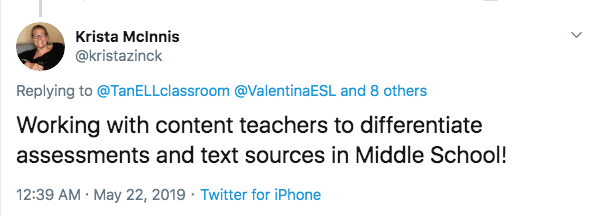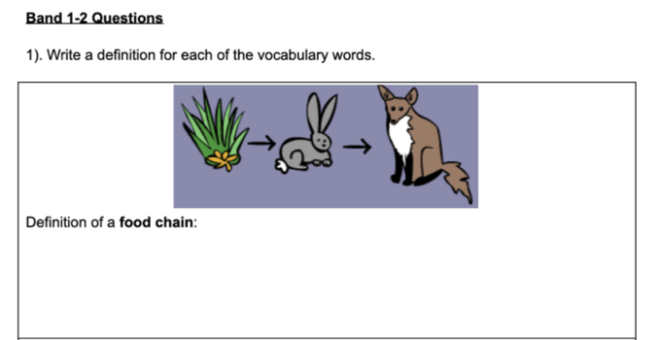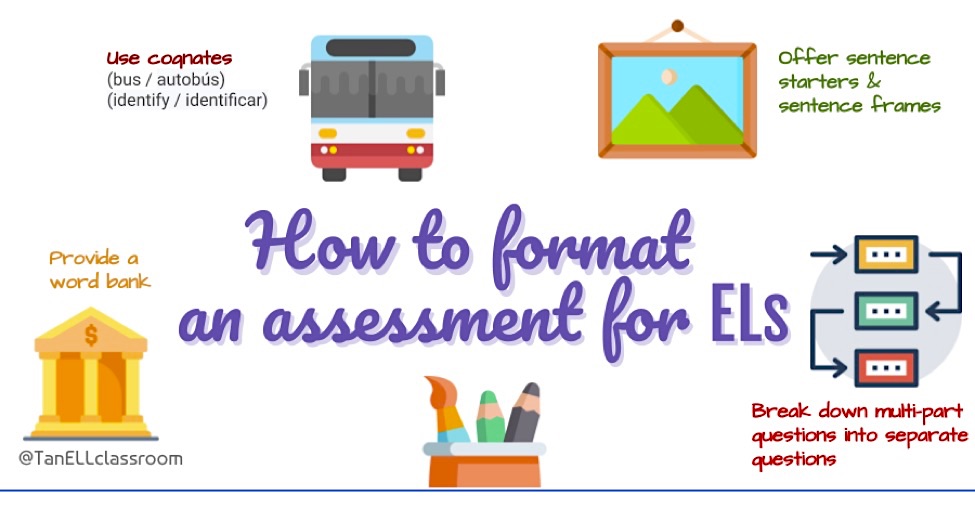Design Your Tests with English Learners in Mind
A MiddleWeb Blog

This week we’ll attempt to tackle Krista McInnis’s topic. She asked about effective ways to work with content area teachers to differentiate assessments and text sources in middle school.
I offered some ideas in September’s article about differentiating instruction while keeping the rigor high. That article is most relevant for you if you want to read about differentiating the process, the content, and the product of a particular lesson.
In this article, I will address how to differentiate the format of the standard paper-and-pencil summative assessment to meet the needs of English learners. (Because the second part of Krista’s topic deserves its own posting, I’ll address how to differentiate text resources for students in my next article.)
Word banks provide the ingredients
Consider giving your students a word bank on the assessment. This is not giving them the answer. You are simply providing them with the necessary ingredients. When we have flour, eggs, butter, and sugar laid out on the kitchen counter, these items by themselves do not create a cake. It’s the way these ingredients are used that creates the cake. An EL-formatted assessment that contains a word bank means that ELs will have the content words, but that in itself does not ensure accurate usage.
However, an assessment without a word bank would unnecessarily tax students who are just developing English skills. They are already tasked with mastering the content and the language required to communicate content-specific objectives. A word bank just reduces the cognitive stress of recalling all of the key words in a unit and their spellings.
There is a clear difference between recalling a word and being able to use it meaningfully. And the latter is far more important. I argue that we must narrow our focus on assessing ELs’ use of content-specific words and not their rote recall of them.
Add visuals to your test
Please add images and diagrams related but not identical to the ones they have seen before. Images can visualize the instructions and immediately make abstract concepts concrete. In the example below, we wanted to test students’ understanding of how a food chain works. Therefore, we provided an image of a food chain that was not shown in class previously. This helped ELs understand the instruction. Sometimes, the greatest hurdles for ELs in successfully engaging in an assessment are the wording and the formatting, not the content of the assessment.
Word banks and images receive the same criticism. People think that the images give away the answer. They do not. They simply make the instructions clearer. If a student does not understand what a food chain is, an image will not help them. If ELs are beginners, they might understand what a food chain is from our instruction. Adding an image may help them recall the instruction and understand what we expect.
Synonyms & Cognates
In the subject areas we teach, we do not want our tests to be reading assessments; we want them to be content assessments. As you design an EL-formatted assessment, pay attention to words that may be too difficult for ELs. Take a look at the prompt below:
Example: Identify the most significant factors that contribute to climate change.
We want to keep the cognitive rigor of this task, yet we want to make the meaning of our request understandable. To do that, provide synonyms along with the difficult words. Do not omit the difficult words – we want students exposed to the academically rigorous vocabulary too. The amplified example might look like this:
Example: Identify (list) the most significant factors (the most important reasons) that contribute to (cause) climate change.
If possible, consider using words from a student’s first language. If you speak Spanish and your ELs are from Spanish-speaking families, using cognates rather than synonyms can also make the assessment more comprehensible.
A cognate is a word that shares a linguistic root with another word. In the example above, there are several words that have Spanish cognates:
Identify: identificar
Significant: significativo
Important: importante
Reasons: razones
Contribute: contribuir
Our example with the cognates included will look like this:
Example: Identify (identificar) the most significant (significativo) factors (las razones más importante) that contribute (contribuir) to climate change.
There are two limitations to using cognates. The first is that it assumes that ELs have already acquired these words in their home language. The second is that it requires the teacher being bilingual – in the language of instruction and their home language.
Sentence starters & frames
English learners often know the answers to our questions, but they do not know how to communicate them. Having sentence starters and frames on EL-formatted assessments can make their ideas more comprehensible. For example, we might use
Sentence starters: The three contributors that cause climate change are…
Sentence frames: The most significant contributor to climate change is…because…
Sentence stems and frames empower ELs to think academically and communicate in the language of the discipline. Some teachers oppose using these supports, believing that they water down the rigor of the assessment. This is simply not the case. Students still must come ready with the answers in hand, or these supports won’t help them at all. Sentences starters and frames don’t give students any substantive answers. They simply help organize, package, and structure students’ responses.
Single-Task Questions
Multi-part questions are everywhere on typical assessments. These are difficult for non-ELs and ELs alike. Answering only one part of the question results in an incomplete response, and answering the last part of the question requires mastery of the first part. This makes multi-part questions highly complex.
Sure, we want to assess ELs’ abilities to think critically about content-specific topics, but does that mean the format of the questions has to be complex too?
Multi-part question: Identify the most significant factors that contribute to climate change and explain their influence.
We can edit the example above in a way that both keeps the academic rigor and supports rather than shackles ELs. Simply break down each of the command terms into its own question. Have the more complex parts of the question proceed after the less complex part.
- Identify all the factors that contribute to climate change.
- Explain how each factor contributes to climate change.
Formatting the assessment this way does not make the academic task simpler. It just makes answering all the parts of the assessment more possible.
It’s Always about Support
Just like we design instruction in ways that support English learners, we need to consciously design assessments to be formatted in ways that support them too.
The specific techniques shared in this article do not provide the answers for students. These techniques expect students to have the answer ready to go. These suggestions just make answering the questions more possible, the highest achievement more attainable, and the final assessment more equitable.





































Hello Tan! I’m seeing your name pop up everywhere! It was fun to visit your classroom at Vientiane International School! Do you remember me?
Hi, Eva.
I sure do. Sorry that we didn’t get to work together while we were both there. VIS is such a magical place! Did you get your teaching degree yet? Are you still there?